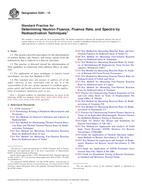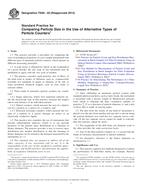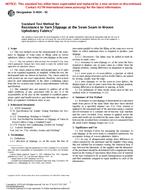Click here to purchase
p id=”s00002″>1.1 These test methods cover procedures for determining the magnitude and rate of consolidation of soil when it is restrained laterally and drained axially while subjected to incrementally applied controlled-stress loading. Two alternative procedures are provided as follows:
1.1.1 Test Method A – This test method is performed with constant load increment duration of 24 h, or multiples thereof. Time-deformation readings are required on a minimum of two load increments. This test method provides only the compression curve of the specimen and the results combine both primary consolidation and secondary compression deformations.
1.1.2 Test Method B – Time-deformation readings are required on all load increments. Successive load increments are applied after 100 % primary consolidation is reached, or at constant time increments as described in Test Method A. This test method provides the compression curve with explicit data to account for secondary compression, the coefficient of consolidation for saturated materials, and the rate of secondary compression.
Note 1 – The determination of the rate and magnitude of consolidation of soil when it is subjected to controlled-strain loading is covered by Test Method D4186.
1.2 These test methods are most commonly performed on saturated intact samples of fine grained soils naturally sedimented in water, however, the basic test procedure is applicable, as well, to specimens of compacted soils and intact samples of soils formed by other processes such as weathering or chemical alteration. Evaluation techniques specified in these test methods assume the pore space is fully saturated and are generally applicable to soils naturally sedimented in water. Tests performed on other unsaturated materials such as compacted and residual (weathered or chemically altered) soils may require special evaluation techniques. In particular, the rate of consolidation (interpretation of the time curves) is only applicable to fully saturated specimens.
1.3 It shall be the responsibility of the agency requesting this test to specify the magnitude and sequence of each load increment, including the location of a rebound cycle, if required, and, for Test Method A, the load increments for which time-deformation readings are desired. The required maximum stress level depends on the purpose of the test and must be agreed on with the requesting agency. In the absence of specific instructions, Section 11 provides the default load increment and load duration schedule for a standard test.
Note 2 – Time-deformation readings are required to determine the time for completion of primary consolidation and for evaluating the coefficient of consolidation, cv. Since cv varies with stress level and loading type (loading or unloading), the load increments with timed readings must be selected with specific reference to the individual project. Alternatively, the requesting agency may specify Test Method B wherein the time-deformation readings are taken on all load increments.
1.4 These test methods do not address the use of a back pressure to saturate the specimen. Equipment is available to perform consolidation tests using back pressure saturation. The addition of back pressure saturation does not constitute non-conformance to these test methods.
1.5 Units – The values stated in either SI units or inch-pound units [given in brackets] are to be regarded separately as standard. The values stated in each system may not be exact equivalents; therefore, each system shall be used independently of the other. Combining values from the two systems may result in non-conformance with the standard.
1.5.1 In the engineering profession it is customary practice to use, interchangeably, units representing both mass and force, unless dynamic calculations (F = Ma) are involved. This implicitly combines two separate systems of units, that is, the absolute system and the gravimetric system. It is scientifically undesirable to combine two separate systems within a single standard. This test method has been written using SI units; however, inch-pound conversions are given in the gravimetric system, where the pound (lbf) represents a unit of force (weight). The use of balances or scales recording pounds of mass (lbm), or the recording of density in lb/ft3 should not be regarded as nonconformance with this test method.
1.6 Observed and calculated values shall conform to the guidelines for significant digits and rounding established in Practice D6026, unless superseded by this test method.
1.6.1 The method used to specify how data are collected, calculated, or recorded in this standard is not directly related to the accuracy to which the data can be applied in design or other uses, or both. How one applies the results obtained using this standard is beyond its scope.
1.7 This standard does not purport to address all of the safety concerns, if any, associated with its use. It is the responsibility of the user of this standard to establish appropriate safety and health practices and determine the applicability of regulatory limitations prior to use.
Product Details
- Published:
- 05/01/2011
- Number of Pages:
- 15
- File Size:
- 1 file , 360 KB
- Redline File Size:
- 2 files , 730 KB


